On the Complexity Analysis and Visualization of Musical Information
Abstract
1. Introduction
2. Mathematical Background
2.1. Entropy
2.2. Permutation Entropy
- For each , with ,1.1 compose the sequence ;1.2 construct the dimensional array ;1.3 sort the array by increasing order of the elements in the first row;1.4 denote by the sequence of numbers in the second row of the sorted array;
- Compute the probability distribution , where W is a random variable with sample space and , for ;
- Calculate as
2.3. Statistical Complexity
2.4. Kolmogorov Complexity
2.5. Multidimensional Scaling
2.6. Musical Sounds
3. Complexity Analysis and Visualization
3.1. Frank Sinatra
3.2. Rolling Stones
3.3. Johnny Hallyday
3.4. Julio Iglesias
4. Conclusions
Author Contributions
Funding
Conflicts of Interest
References
- Meredith, D. Computational Music Analysis; Springer: Berlin/Heidelberg, Germany, 2016; Volume 62. [Google Scholar]
- Roberts, G.E. From Music to Mathematics: Exploring the Connections; JHU Press: Baltimore, MD, USA, 2016. [Google Scholar]
- Burkholder, J.P.; Grout, D.J. A History of Western Music: Ninth International Student Edition; WW Norton & Company: New York, NY, USA, 2014. [Google Scholar]
- Christensen, T. The Cambridge History of Western Music Theory; Cambridge University Press: Cambridge, UK, 2006. [Google Scholar]
- Davies, B. Exploring Chaos: Theory and Experiment; CRC Press: Boca Raton, FL, USA, 2018. [Google Scholar]
- Tang, L.; Lv, H.; Yang, F.; Yu, L. Complexity testing techniques for time series data: A comprehensive literature review. Chaos Solitons Fractals 2015, 81, 117–135. [Google Scholar] [CrossRef]
- Tarasov, V.E.; Tarasova, V.V. Time-dependent fractional dynamics with memory in quantum and economic physics. Ann. Phys. 2017, 383, 579–599. [Google Scholar] [CrossRef]
- Bonanno, G.; Lillo, F.; Mantegna, R.N. Levels of complexity in financial markets. Physica A 2001, 299, 16–27. [Google Scholar] [CrossRef]
- Machado, J.T.; Lopes, A.M. Analysis of natural and artificial phenomena using signal processing and fractional calculus. Fract. Calc. Appl. Anal. 2015, 18, 459–478. [Google Scholar] [CrossRef]
- Ionescu, C.; Lopes, A.; Copot, D.; Machado, J.T.; Bates, J. The role of fractional calculus in modeling biological phenomena: A review. Commun. Nonlinear Sci. Numer. Simul. 2017, 51, 141–159. [Google Scholar] [CrossRef]
- Perc, M.; Jordan, J.J.; Rand, D.G.; Wang, Z.; Boccaletti, S.; Szolnoki, A. Statistical physics of human cooperation. Phys. Rep. 2017, 687, 1–51. [Google Scholar] [CrossRef]
- Stanley, H.E. Phase Transitions and Critical Phenomena; Clarendon Press: Oxford, UK, 1971. [Google Scholar]
- Dogson, N.A. Mathematical characterisation of Bridget Riley’s stripe paintings. J. Math. Arts 2012, 5, 1–12. [Google Scholar]
- Sigaki, H.Y.; Perc, M.; Ribeiro, H.V. History of art paintings through the lens of entropy and complexity. Proc. Natl. Acad. Sci. USA 2018, 115, E8585–E8594. [Google Scholar] [CrossRef] [PubMed]
- Machado, J.T.; Lopes, A.M. Artistic painting: A fractional calculus perspective. Appl. Math. Model. 2019, 65, 614–626. [Google Scholar] [CrossRef]
- Boon, J.P.; Casti, J.; Taylor, R.P. Artistic forms and complexity. Nonlinear-Dyn.-Psychol. Life Sci. 2011, 15, 265. [Google Scholar]
- Taylor, R.; Micolich, A.; Jones, D. Fractal expressionism. Phys. World 1999, 12, 1–3. [Google Scholar] [CrossRef]
- De la Calleja, E.; Cervantes, F.; De la Calleja, J. Order-fractal transitions in abstract paintings. Ann. Phys. 2016, 371, 313–322. [Google Scholar] [CrossRef]
- Montagner, C.; Linhares, J.M.; Vilarigues, M.; Nascimento, S.M. Statistics of colors in paintings and natural scenes. J. Opt. Soc. Am. A Opt. Image Sci. Vis. 2016, 33, A170–A177. [Google Scholar] [CrossRef] [PubMed]
- Koch, M.; Denzler, J.; Redies, C. 1/f2 Characteristics and isotropy in the Fourier power spectra of visual art, cartoons, comics, mangas, and different categories of photographs. PLoS ONE 2010, 5, e12268. [Google Scholar] [CrossRef] [PubMed]
- Lopes, A.; Tenreiro Machado, J. Complexity Analysis of Global Temperature Time Series. Entropy 2018, 20, 437. [Google Scholar] [CrossRef]
- Simonton, D.K. Melodic structure and note transition probabilities: A content analysis of 15,618 classical themes. Psychol. Music 1984, 12, 3–16. [Google Scholar] [CrossRef]
- Eerola, T.; North, A. Cognitive complexity and the structure of musical patterns. In Proceedings of the 6th International Conference on Music Perception and Cognition, Keele, UK, 5–10 August 2000. [Google Scholar]
- Herrera, P.; Streich, S. Detrended fluctuation analysis of music signals: Danceability estimation and further semantic characterization. In Proceedings of the Audio Engineering Society 118th Convention, Barcelona, Spain, 28–31 May 2005. [Google Scholar]
- Li, M.; Sleep, R. Melody classification using a similarity metric based on Kolmogorov complexity. In Proceedings of the Sound and Music Computing Conference, Paris, France, 20–22 October 2004; Volume 2012. [Google Scholar]
- Ribeiro, H.V.; Zunino, L.; Mendes, R.S.; Lenzi, E.K. Complexity–entropy causality plane: A useful approach for distinguishing songs. Physica A 2012, 391, 2421–2428. [Google Scholar] [CrossRef]
- Hourdin, C.; Charbonneau, G.; Moussa, T. A multidimensional scaling analysis of musical instruments’ time-varying spectra. Comput. Music. J. 1997, 21, 40–55. [Google Scholar] [CrossRef]
- Machado, J.T.; Costa, A.C.; Lima, M.F. Dynamical analysis of compositions. Nonlinear Dyn. 2011, 65, 399–412. [Google Scholar]
- Knautz, K.; Neal, D.R.; Schmidt, S.; Siebenlist, T.; Stock, W.G. Finding emotional-laden resources on the World Wide Web. Information 2011, 2, 217–246. [Google Scholar] [CrossRef]
- Kostagiolas, P.; Lavranos, C.; Manolitzas, P. Survey Data for Measuring Musical Creativity and the Impact of Information. Data 2019, 4, 80. [Google Scholar] [CrossRef]
- Shannon, C. A Mathematical Theory of Communication. Bell Syst. Tech. J. 1948, 27, 379–423. [Google Scholar] [CrossRef]
- Jaynes, E. Information Theory and Statistical Mechanics. Phys. Rev. 1957, 106, 620–630. [Google Scholar] [CrossRef]
- Machado, J.T.; Lopes, A.M. Multidimensional scaling analysis of soccer dynamics. Appl. Math. Model. 2017, 45, 642–652. [Google Scholar] [CrossRef]
- Cover, T.; Thomas, J. Elements of Information Theory; John Wiley & Sons: New York, NY, USA, 1991. [Google Scholar]
- Machado, J.T.; Lopes, A.M. Fractional Rényi entropy. Eur. Phys. J. Plus 2019, 134, 217. [Google Scholar] [CrossRef]
- Knuth, K.H.; Skilling, J. Foundations of inference. Axioms 2012, 1, 38–73. [Google Scholar] [CrossRef]
- Campión, M.J.; Gómez-Polo, C.; Induráin, E.; Raventós-Pujol, A. A Survey on the Mathematical Foundations of Axiomatic Entropy: Representability and Orderings. Axioms 2018, 7, 29. [Google Scholar] [CrossRef]
- Pramanik, S.; Dey, P.; Smarandache, F.; Ye, J. Cross entropy measures of bipolar and interval bipolar neutrosophic sets and their application for multi-attribute decision-making. Axioms 2018, 7, 21. [Google Scholar] [CrossRef]
- Tsallis, C. Approach of complexity in nature: Entropic nonuniqueness. Axioms 2016, 5, 20. [Google Scholar] [CrossRef]
- Bandt, C.; Pompe, B. Permutation entropy: A natural complexity measure for time series. Phys. Rev. Lett. 2002, 88, 174102. [Google Scholar] [CrossRef]
- Berger, S.; Schneider, G.; Kochs, E.; Jordan, D. Permutation Entropy: Too Complex a Measure for EEG Time Series? Entropy 2017, 19, 692. [Google Scholar] [CrossRef]
- Lopez-Ruiz, R.; Mancini, H.L.; Calbet, X. A statistical measure of complexity. Phys. Lett. A 1995, 209, 321–326. [Google Scholar] [CrossRef]
- Martin, M.; Plastino, A.; Rosso, O. Generalized statistical complexity measures: Geometrical and analytical properties. Physica A 2006, 369, 439–462. [Google Scholar] [CrossRef]
- Rosso, O.; Larrondo, H.; Martin, M.; Plastino, A.; Fuentes, M. Distinguishing noise from chaos. Phys. Rev. Lett. 2007, 99, 154102. [Google Scholar] [CrossRef] [PubMed]
- Kolmogorov, A.N. Three approaches to the quantitative definition of information’. Probl. Inf. Transm. 1965, 1, 1–7. [Google Scholar] [CrossRef]
- Antão, R.; Mota, A.; Machado, J.T. Kolmogorov complexity as a data similarity metric: Application in mitochondrial DNA. Nonlinear Dyn. 2018, 93, 1059–1071. [Google Scholar] [CrossRef]
- Lempel, A.; Ziv, J. On the complexity of finite sequences. IEEE Trans. Inf. Theory 1976, 22, 75–81. [Google Scholar] [CrossRef]
- Gordon, G. Multi-dimensionalensional linguistic complexity. J. Biomol. Struct. Dyn. 2003, 20, 747–750. [Google Scholar] [CrossRef]
- Dix, T.I.; Powell, D.R.; Allison, L.; Bernal, J.; Jaeger, S.; Stern, L. Comparative analysis of long DNA sequences by per element information content using different contexts. BMC Bioinform. 2007, 8, S10. [Google Scholar] [CrossRef]
- Molchanov, V.; Linsen, L. Upsampling for Improved Multidimensional Attribute Space Clustering of Multifield Data. Information 2018, 9, 156. [Google Scholar] [CrossRef]
- Gorokhovatskyi, O.; Gorokhovatskyi, V.; Peredrii, O. Analysis of Application of Cluster Descriptions in Space of Characteristic Image Features. Data 2018, 3, 52. [Google Scholar] [CrossRef]
- Li, Q.; Ma, Y.; Smarandache, F.; Zhu, S. Single-valued neutrosophic clustering algorithm based on Tsallis entropy maximization. Axioms 2018, 7, 57. [Google Scholar] [CrossRef]
- Zhang, H.; Wang, Y.; Wu, D.; Chen, J. Evolutionary Path of Factors Influencing Life Satisfaction among Chinese Elderly: A Perspective of Data Visualization. Data 2018, 3, 35. [Google Scholar] [CrossRef]
- Fiori, S. Visualization of Riemannian-manifold-valued elements by multidimensional scaling. Neurocomputing 2011, 74, 983–992. [Google Scholar] [CrossRef]
- Saeed, N.; Nam, H.; Haq, M.I.U.; Muhammad Saqib, D.B. A Survey on Multidimensional Scaling. ACM Comput. Surv. (CSUR) 2018, 51, 47. [Google Scholar] [CrossRef]
- Tenreiro Machado, J.; Lopes, A.; Galhano, A. Multidimensional scaling visualization using parametric similarity indices. Entropy 2015, 17, 1775–1794. [Google Scholar] [CrossRef]
- Machado, J.; Mendes Lopes, A. Fractional Jensen–Shannon analysis of the scientific output of researchers in fractional calculus. Entropy 2017, 19, 127. [Google Scholar] [CrossRef]
- Lartillot, O.; Toiviainen, P.; Eerola, T. A Matlab toolbox for music information retrieval. In Data Analysis, Machine Learning and Applications; Springer: Berlin/Heidelberg, Germany, 2008; pp. 261–268. [Google Scholar]
- Giannakopoulos, T. pyAudioanalysis: An open-source python library for audio signal analysis. PLoS ONE 2015, 10, e0144610. [Google Scholar] [CrossRef]
- McFee, B.; Raffel, C.; Liang, D.; Ellis, D.P.; McVicar, M.; Battenberg, E.; Nieto, O. Librosa: Audio and music signal analysis in python. In Proceedings of the 14th Python in Science Conference, Austin, TX, USA, 6–12 July 2015; pp. 18–25. [Google Scholar]
- Papakostas, M.; Giannakopoulos, T. Speech-music discrimination using deep visual feature extractors. Expert Syst. Appl. 2018, 114, 334–344. [Google Scholar] [CrossRef]
- Pikrakis, A.; Giannakopoulos, T.; Theodoridis, S. A speech/music discriminator of radio recordings based on dynamic programming and bayesian networks. IEEE Trans. Multimed. 2008, 10, 846–857. [Google Scholar] [CrossRef]
- Deza, M.M.; Deza, E. Encyclopedia of Distances; Springer: Berlin/Heidelberg, Germany, 2009. [Google Scholar]
- Carr, J.C.; Fright, W.R.; Beatson, R.K. Surface interpolation with radial basis functions for medical imaging. IEEE Trans. Med Imaging 1997, 16, 96–107. [Google Scholar] [CrossRef] [PubMed]
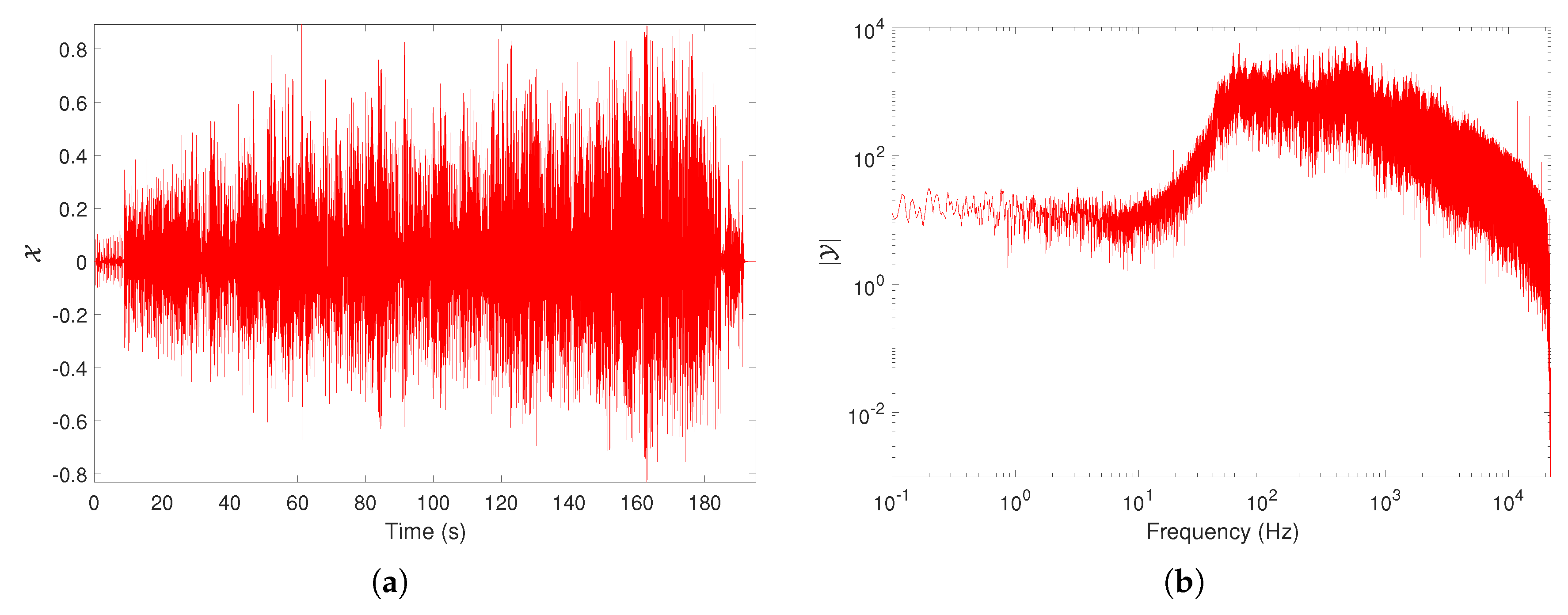
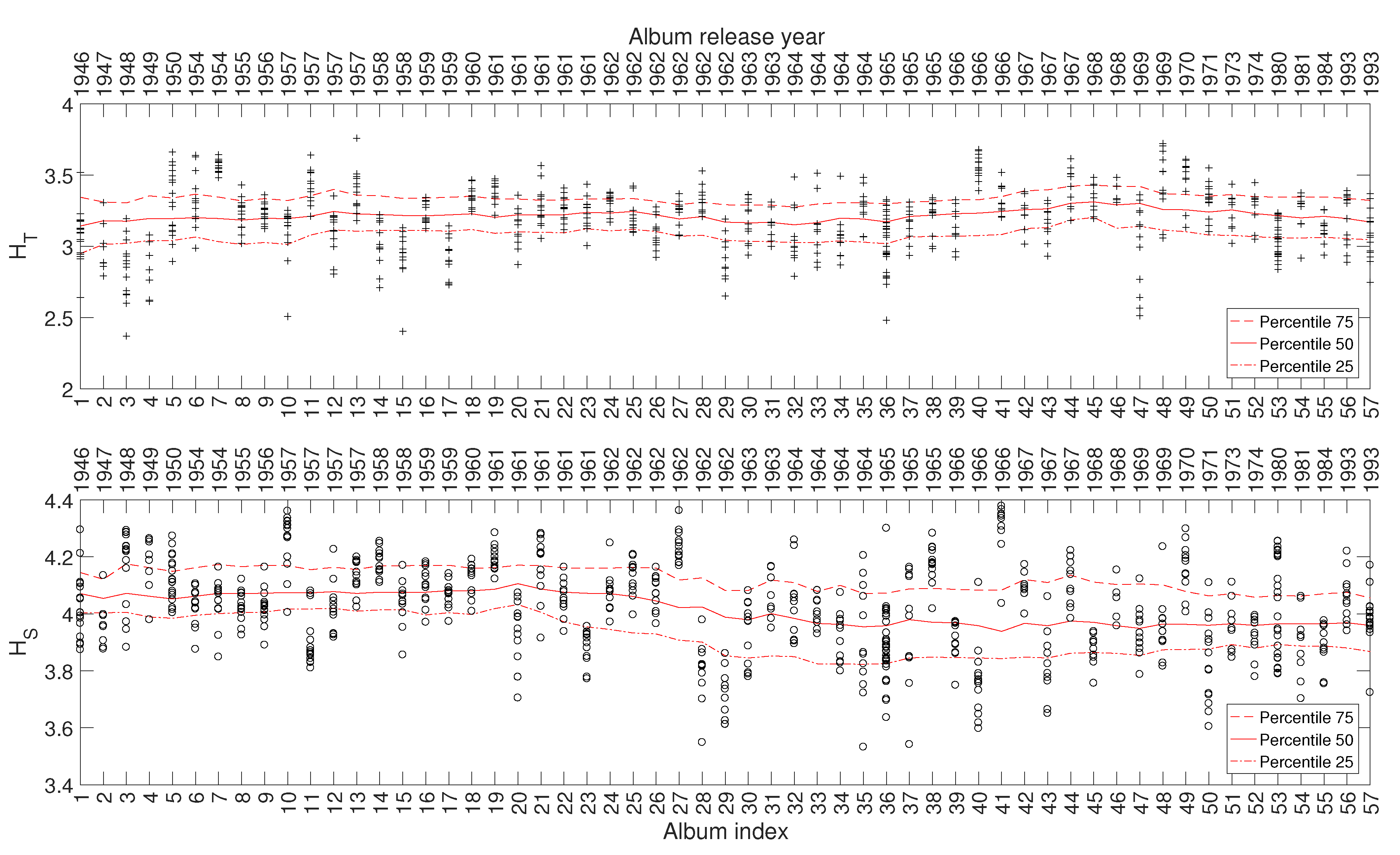
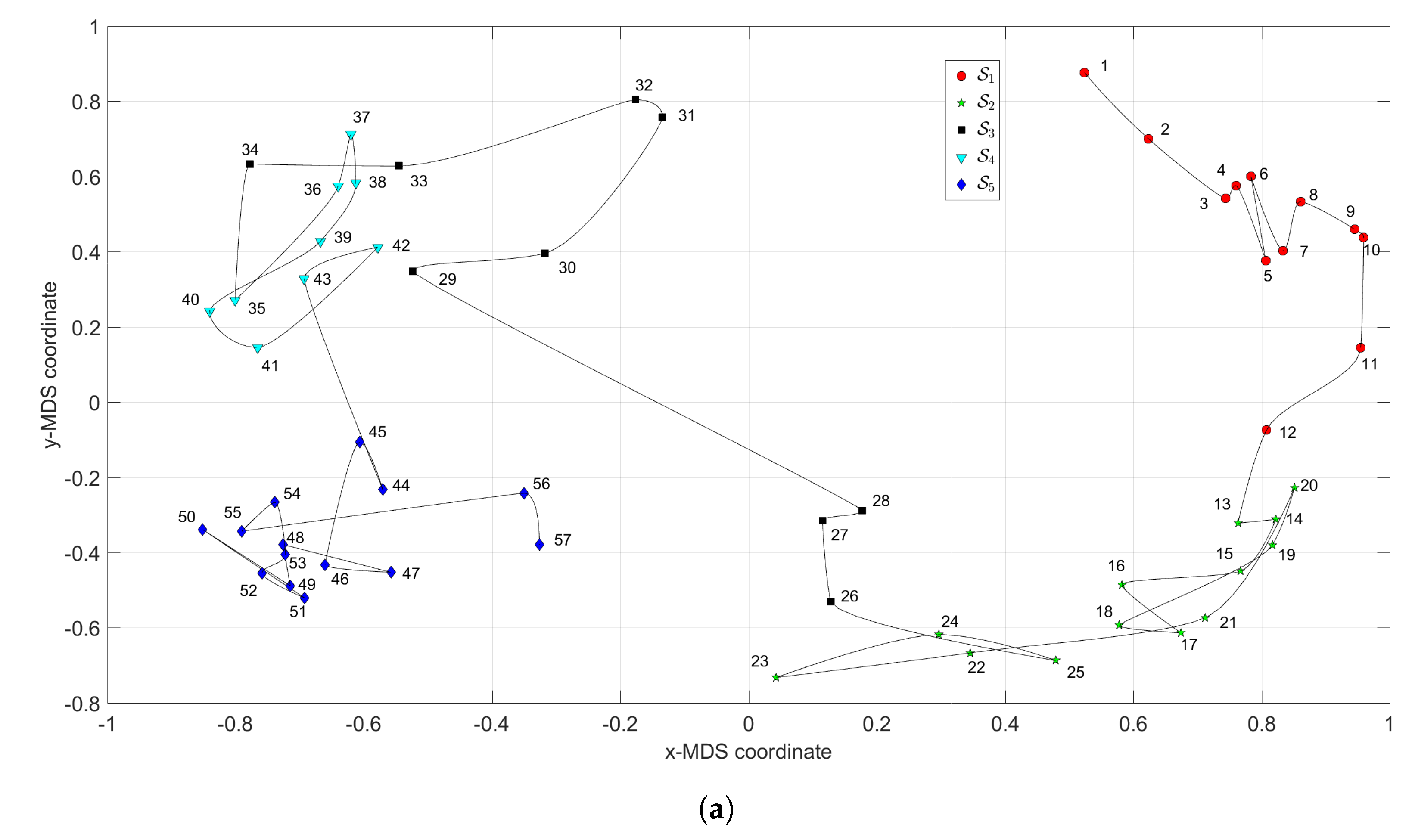
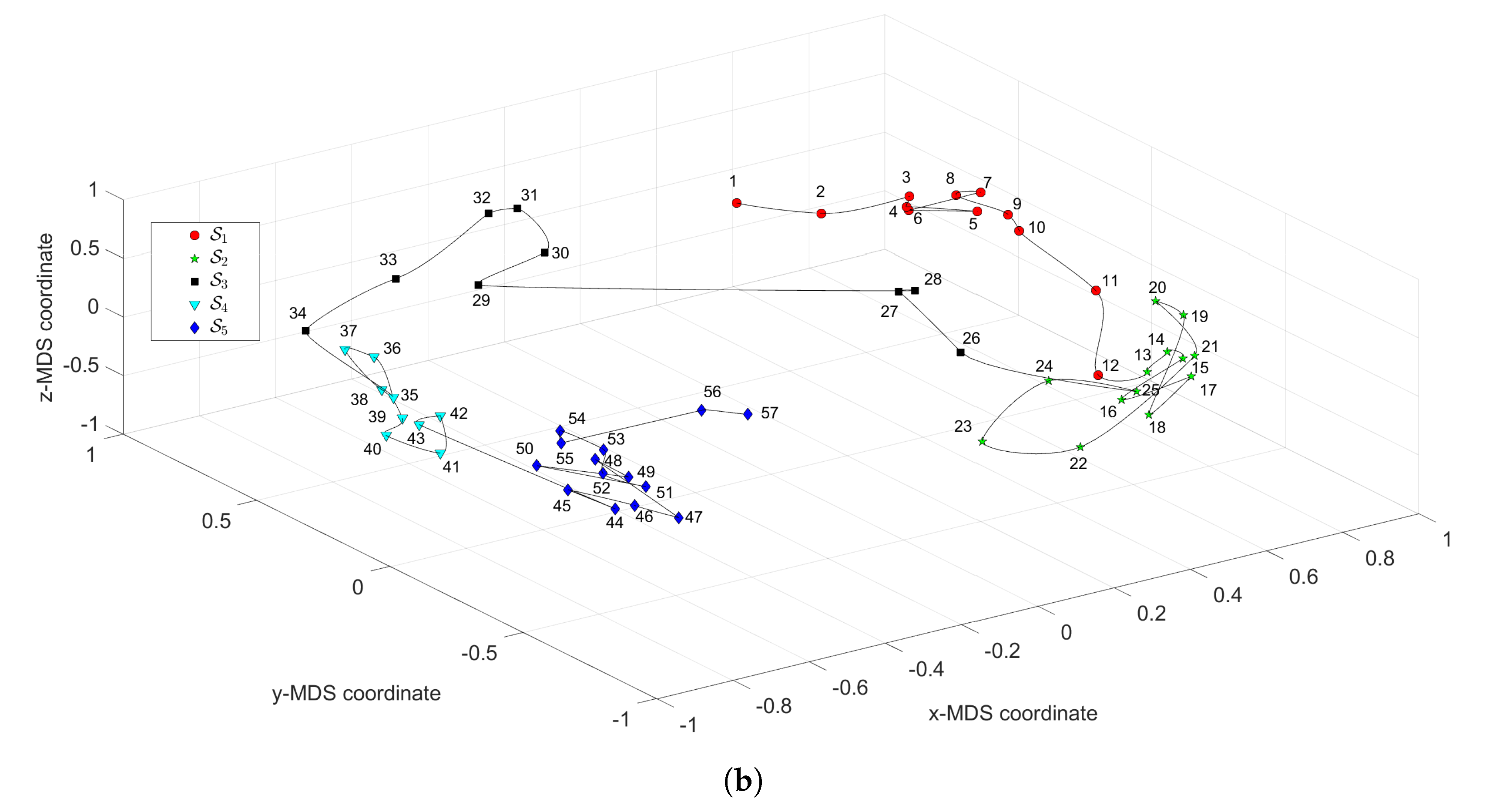

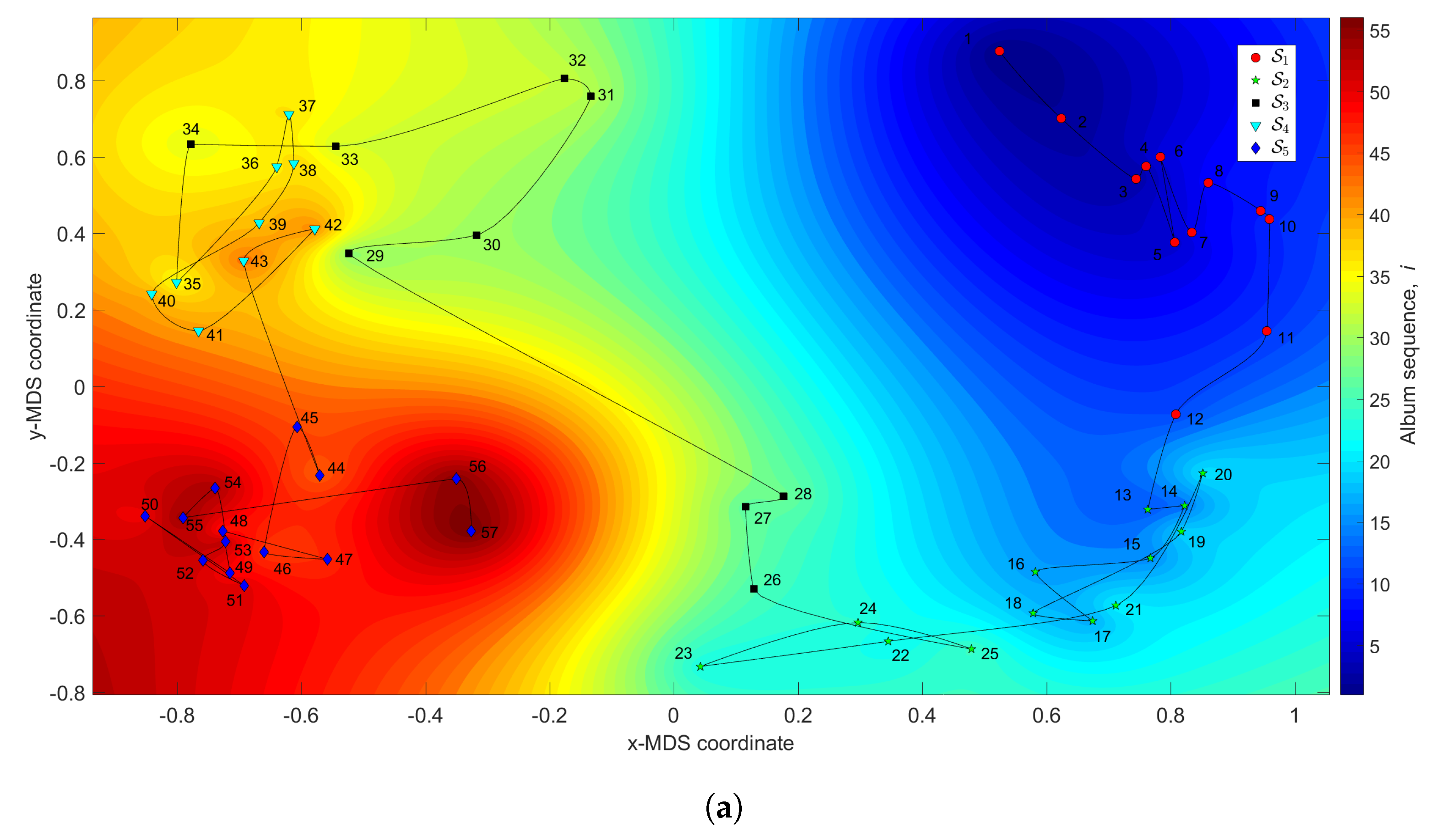
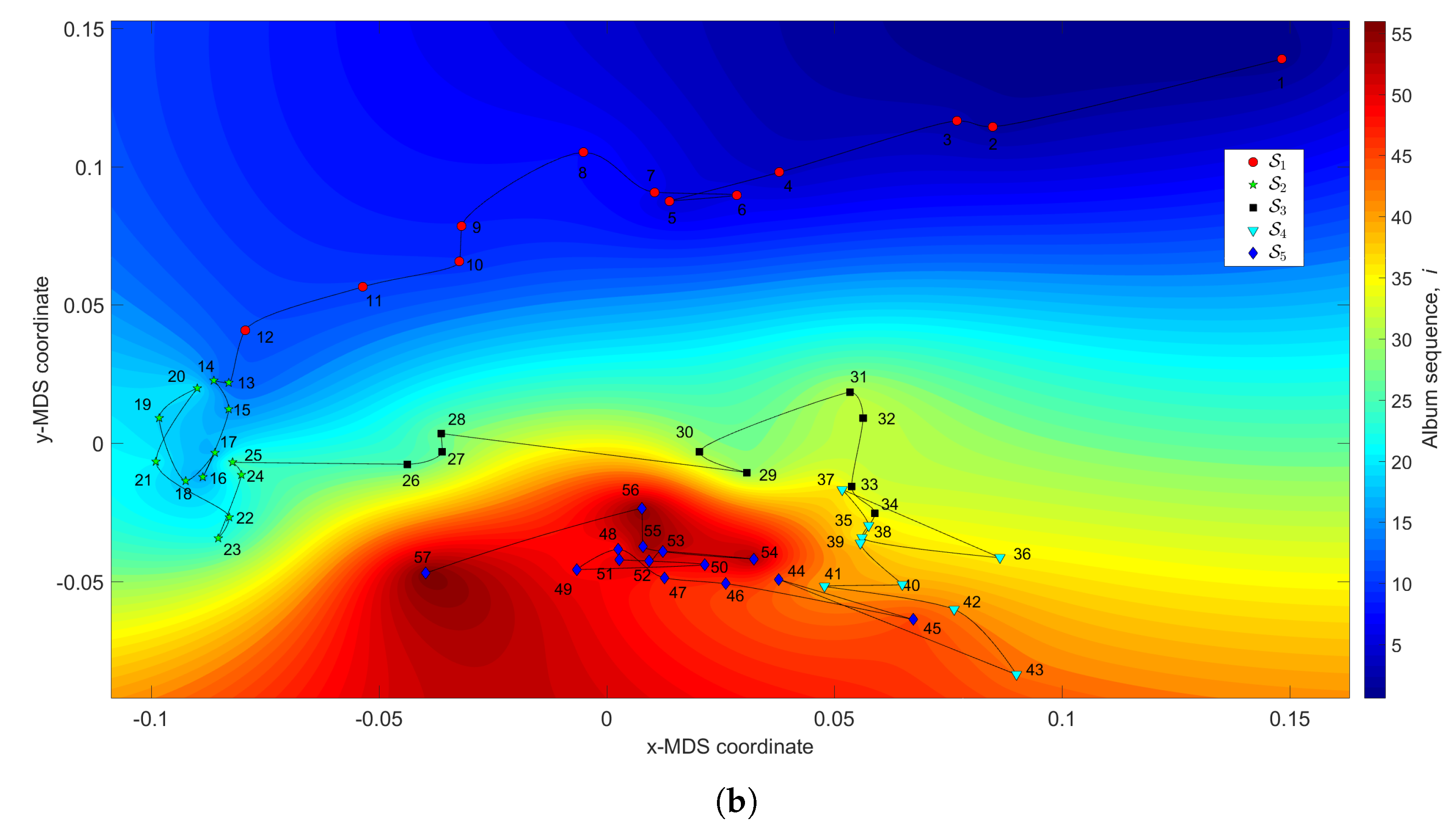
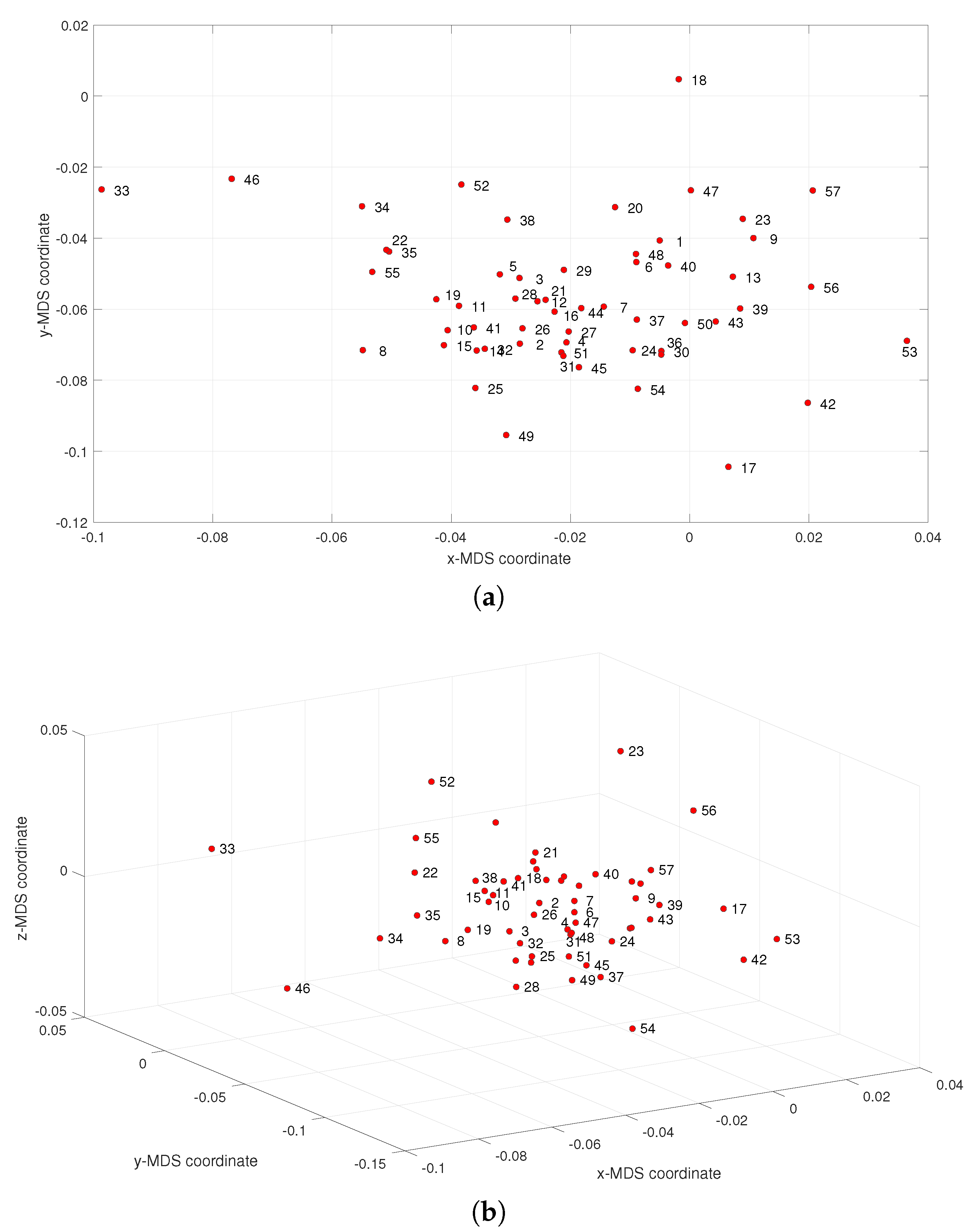
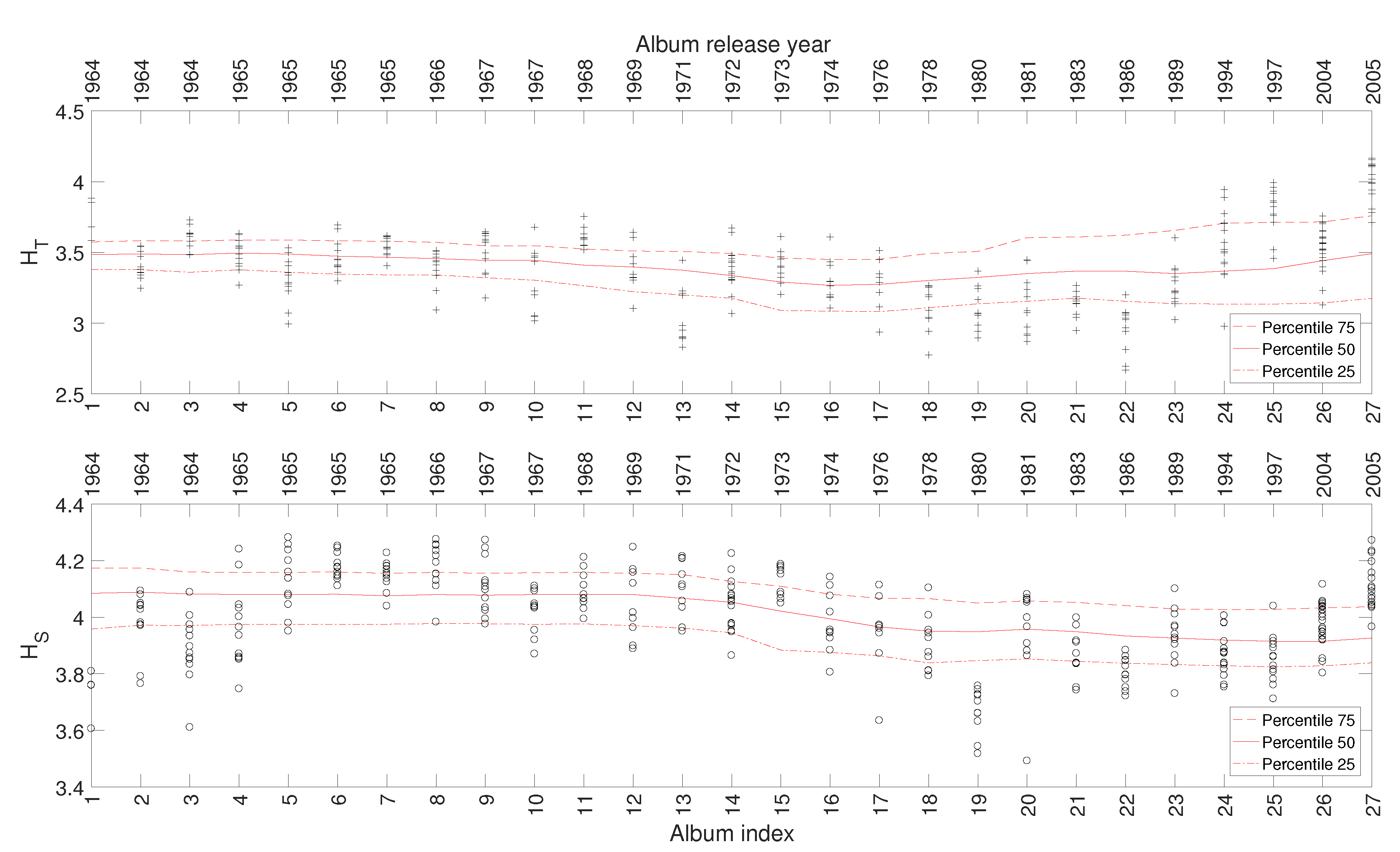
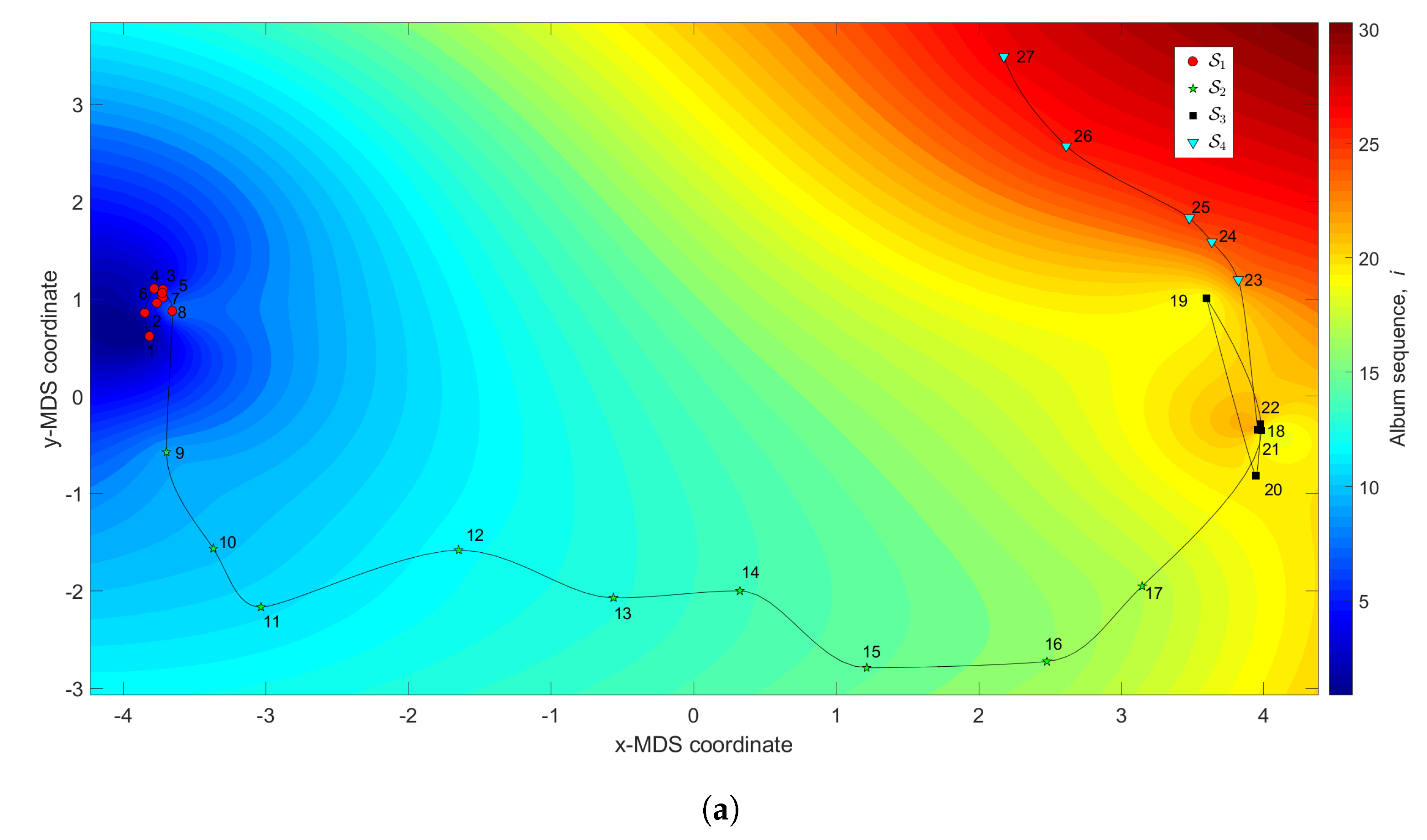
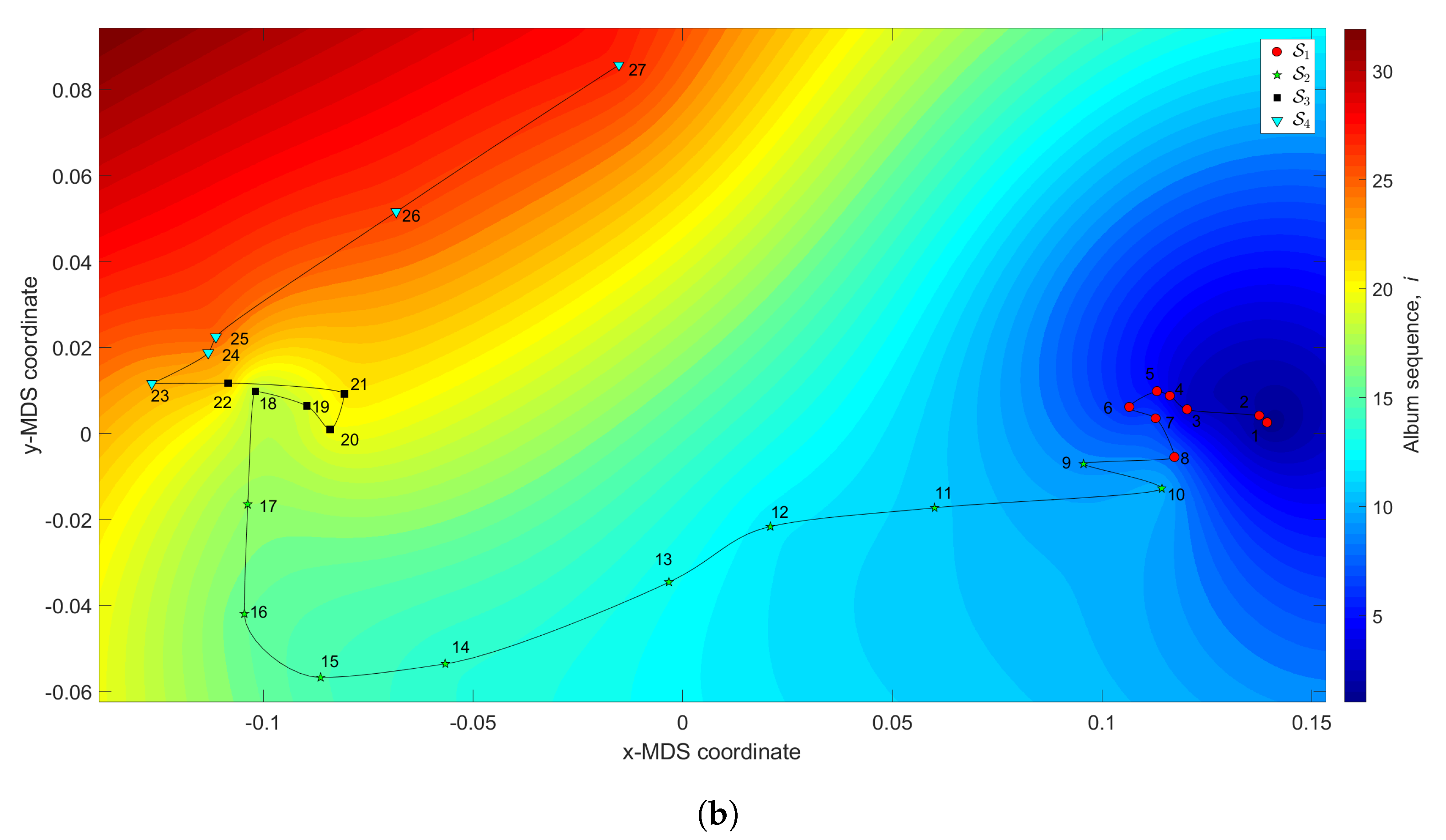
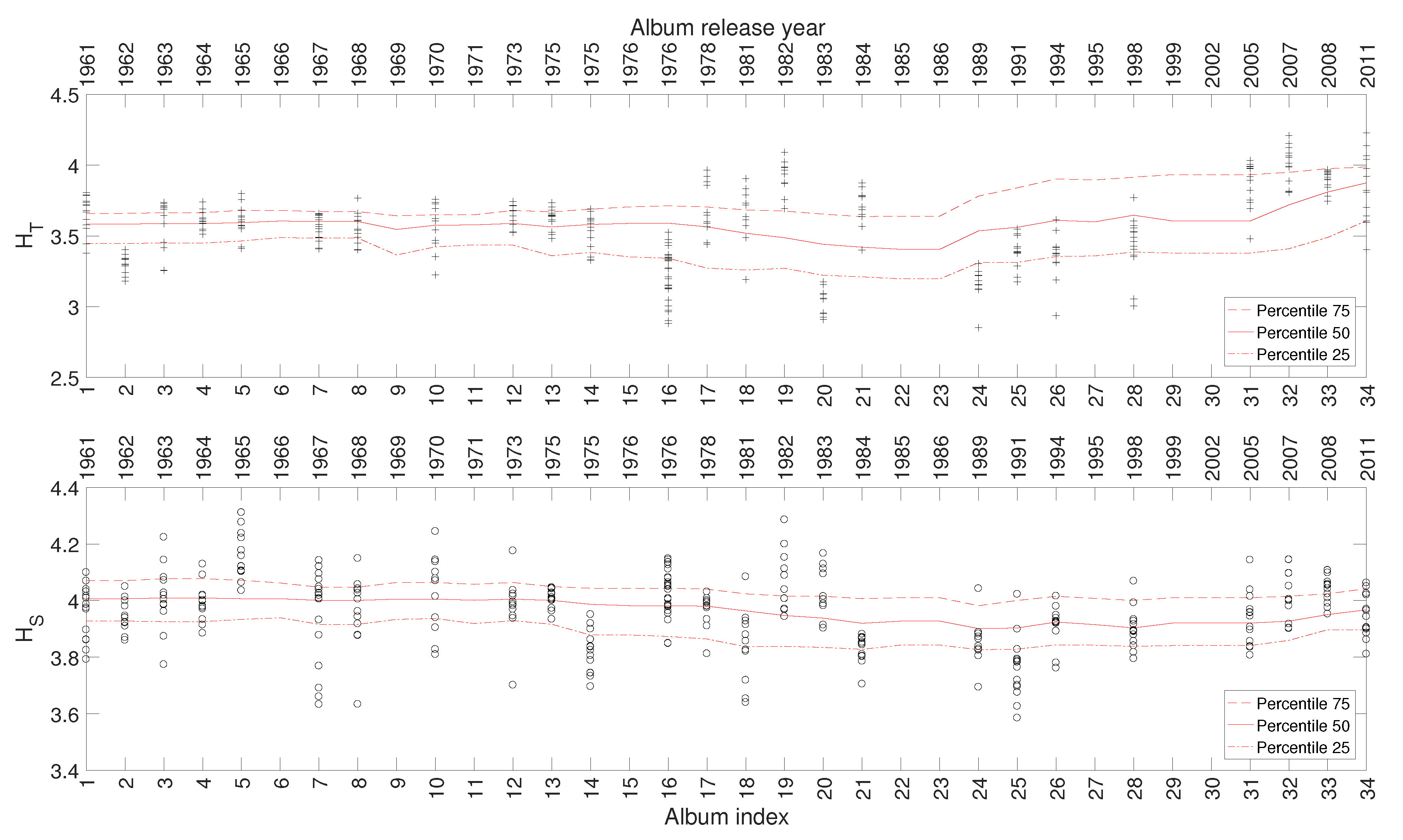
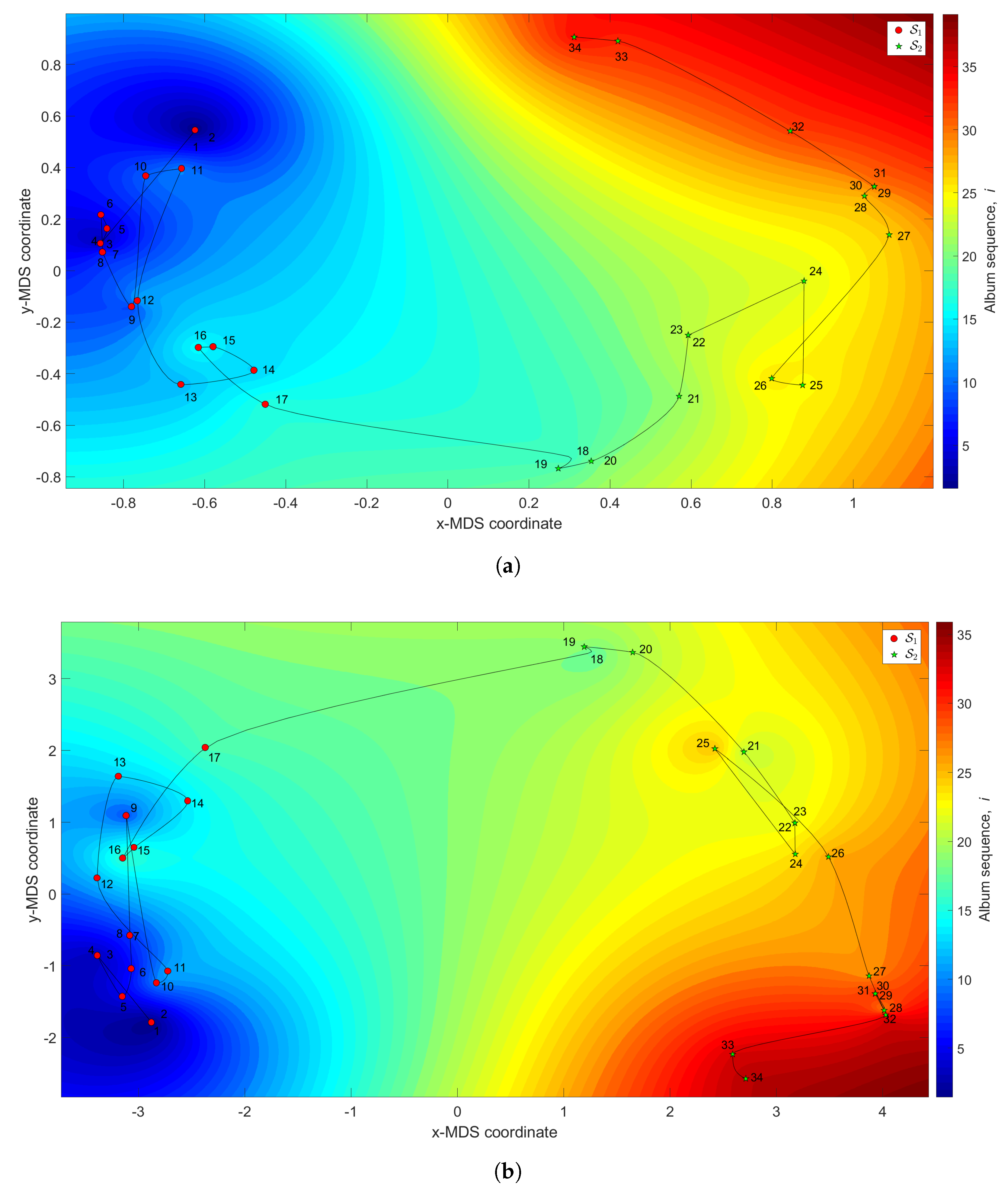
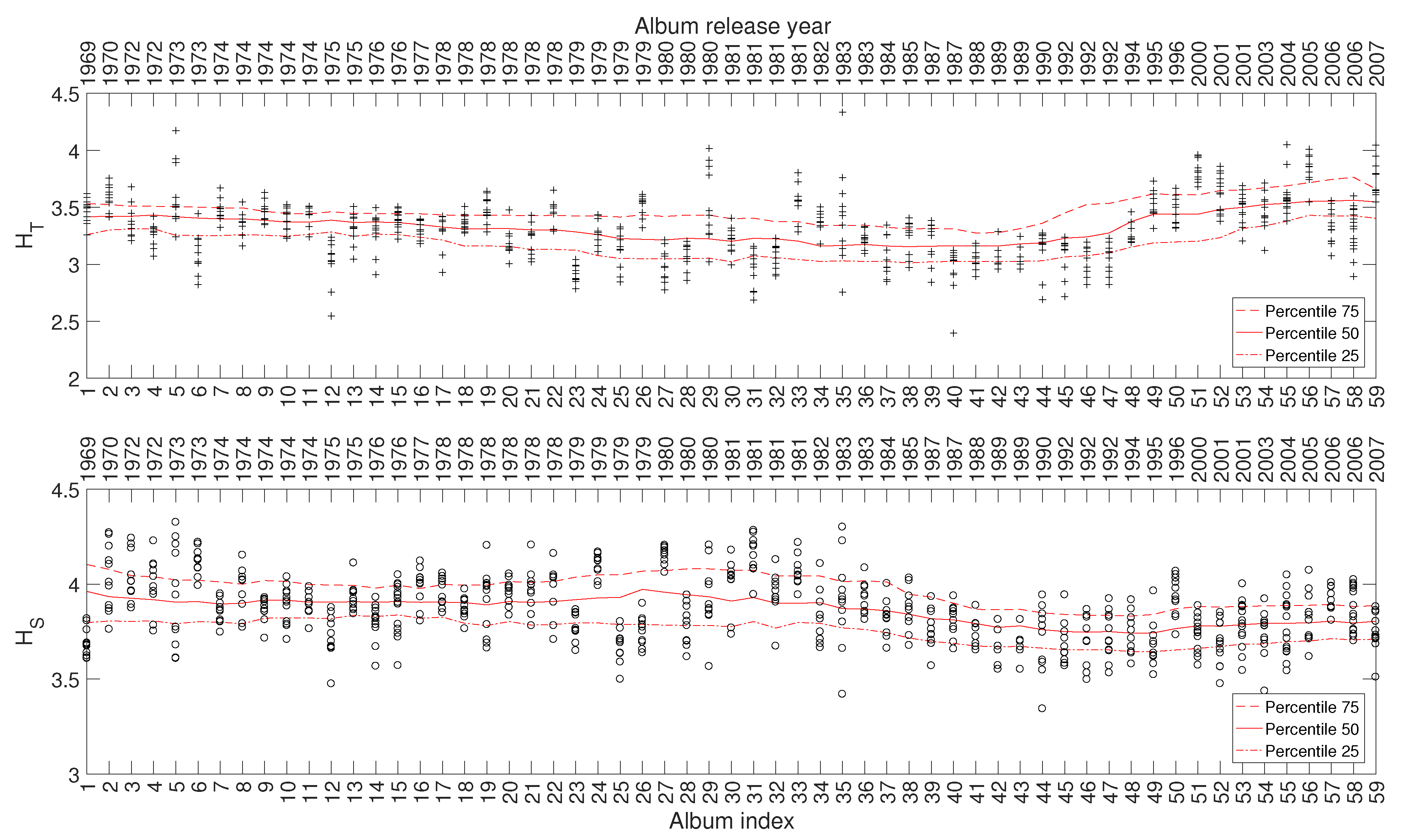
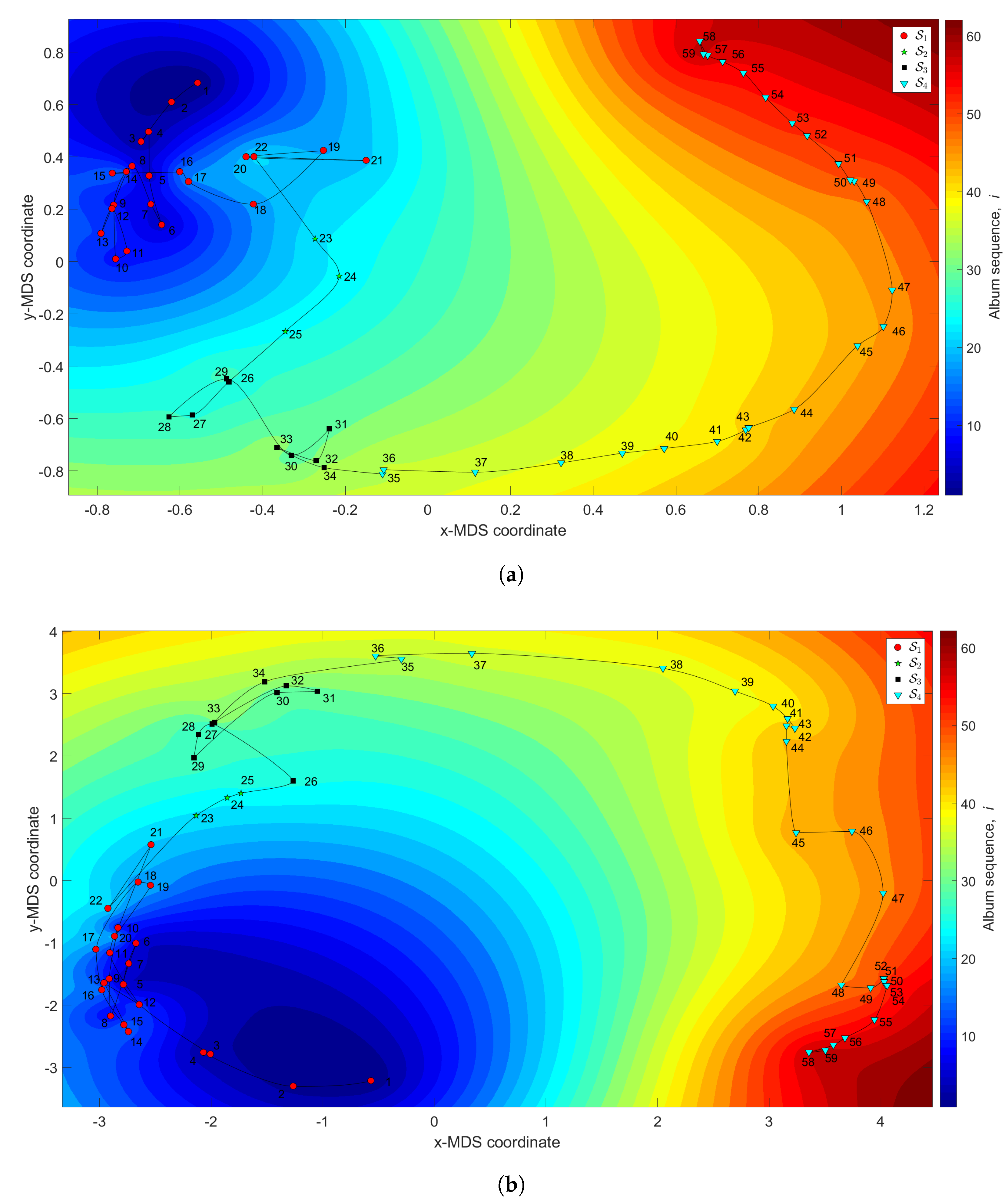
© 2019 by the authors. Licensee MDPI, Basel, Switzerland. This article is an open access article distributed under the terms and conditions of the Creative Commons Attribution (CC BY) license (http://creativecommons.org/licenses/by/4.0/).
Share and Cite
Lopes, A.M.; Tenreiro Machado, J.A. On the Complexity Analysis and Visualization of Musical Information. Entropy 2019, 21, 669. https://doi.org/10.3390/e21070669
Lopes AM, Tenreiro Machado JA. On the Complexity Analysis and Visualization of Musical Information. Entropy. 2019; 21(7):669. https://doi.org/10.3390/e21070669
Chicago/Turabian StyleLopes, António M., and J. A. Tenreiro Machado. 2019. "On the Complexity Analysis and Visualization of Musical Information" Entropy 21, no. 7: 669. https://doi.org/10.3390/e21070669
APA StyleLopes, A. M., & Tenreiro Machado, J. A. (2019). On the Complexity Analysis and Visualization of Musical Information. Entropy, 21(7), 669. https://doi.org/10.3390/e21070669




